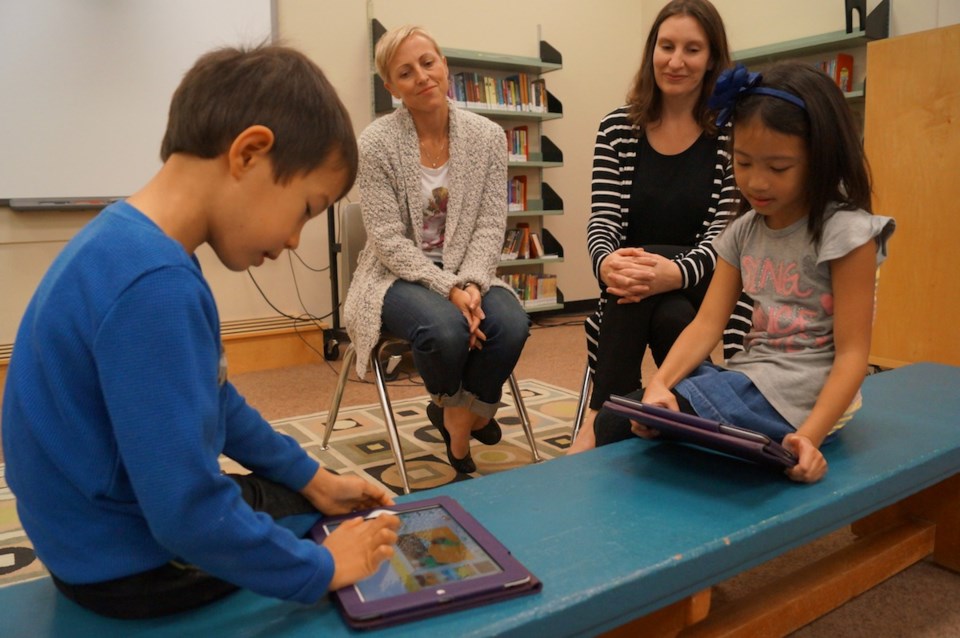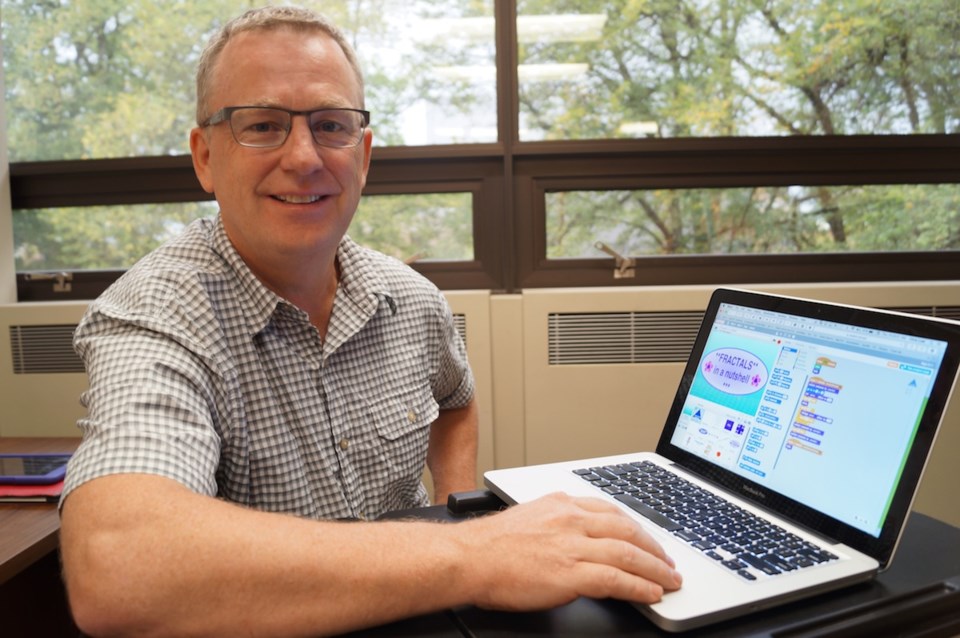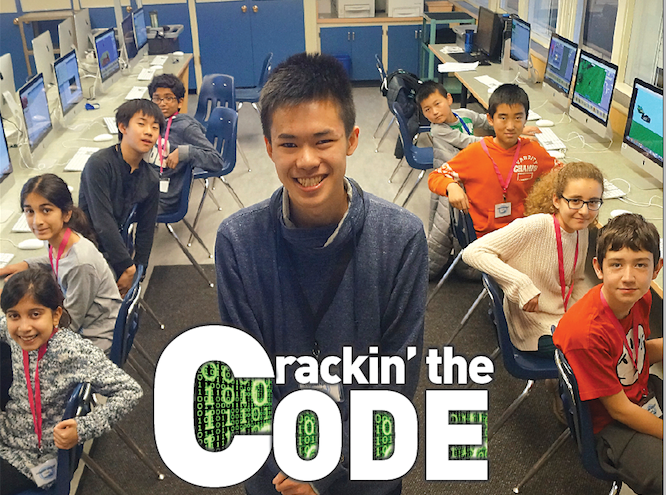As the downloading of the digital revolution on society continues at an ever-increasing pace, Canadian students are shifting from simply understanding how to use a computer, to beginning to understand how a computer works.
To do so, they must speak the computer’s language, and that language is source code.
But as students expand their digital knowledge, educators will be tasked to ensure the fundamental tenets of learning are not deleted.
Last Friday, more than 200 students at McNair secondary school took part in the Hour of Code, an online seminar at code.org that has spread throughout 180 countries in over 40 languages.
The Hour of Code — co-sponsored by Apple, Microsoft and a host of non-profit groups to promote computer sciences — provides students with a basic introduction to computer code, according to McNair’s computer programming teacher Simon Nowak.
“It’s kind of like learning a new language and we’re trying to get to have the younger students learn this at an earlier age,” said Nowak.

Source code — such as JavaScript, HTML or CSS — dictates how a computer program or website looks and operates.
The free seminar shows students how to, for example, move a cartoon character on the screen by moving blocks of code into a script.
For instance, one block of code may tell the character to move left, or right, while another block may move the left hand up or down.
Nowak prefers to use the program Code Avengers to allow students to build a game with their codes.
“It’s a great way to code using some graphic games the students are used to,” said Nowak.
According to McNair’s vice-principal, and self-professed techie, Wennie Walker, an age and gender divide exists when it comes to understanding code; most senior students are unfamiliar with coding, granted the Richmond School District has just begun implementing beginner coding lessons at the elementary level.
“There is an age gap with these kids. We definitely see the Grade 8 students grasp the concept a bit better than, say, the Grade 12’s,” said Walker.
Meanwhile, Walker is being proactive to include girls in coding.
“It can be intimidating. The girls will enjoy it in Grade 8 but it peters off,” said Walker.
Nowak said having gender equality in computer sciences “broadens strokes of creativity,” while Walker noted if more women entered into the well-paying computer science job market, it could help mitigate income gaps between men and women.
An early start
Getting an early start to coding is what Grade 11 McMath student Andrew Tong is hoping to promote through an animation course he plans to run out of a local community centre.
Tong is already teaching coding and animation to a group of girls and boys at Blundell elementary every Wednesday.
“There’s a misconception that computers, animation and programming is for boys. For what reason, I don’t know; it’s just the norm that developed. But, it’s definitely not true, anyone can animate,” he said.
The young entrepreneur said he started to learn how to animate on his own, about four years ago. He now has his own website and YouTube channel to talk about animation.

“It’s putting your vision into a computer screen, making something that’s not living and bringing it to life by materializing that vision,” said Tong, whose seminars use the coding program Alice to allow the students to move their Minecraft characters on the screen.
Once students understand how code works, they may eventually move on to writing code, said Tong.
Tong said his five-week seminar emphasizes and helps develop skills such as spatial thinking, creativity and problem solving, in addition to the obvious computer skills.
“Coding is a skill that isn’t easily trained and it is vital for the kids to learn in the future,” said Tong, noting coding has helped him develop a better work ethic.
“In animating, you have to bog down and work on your own. It’s helped me with other stuff in school, like taking tests.”
While Tong’s coding class is geared toward older elementary students, early introductions to the basic concept of computer code are taking place across the district.
As Grade 1 Manoah Steves student Brendan Young opens his school iPad and taps on the Scratch Jr. app to create a story of his own, he is unknowingly building the fundamentals to understanding how a computer operates.
On this occasion, Young chooses the “Run a Race” feature, which takes him to an animal farm. He selects the horse and pig and drags them onto the screen. After placing a few directional arrows on the screen he pushes the play button and off they go.
With the arrows, Brendan has written the code for his animals’ movements.
Steves’ principal Liz Taylor said coding helps students understand algorithms.
“Coding will become more important over time. It’s a digital language we want kids to practise just as much as we want them to problem-solve, think critically, and be good ‘digital citizens,’” said Taylor.
Likewise, Nowak said learning code helps students better understand logical thinking and planning.
“It’s important to understand step-by-step instructions. Kids these days want end results. They can’t follow through steps. Take home economics. You need to follow steps to make something. So, to be able to slow down and understand how something works, I think is something that is lost on a lot of kids,” said Nowak.
As students become more fluent in this digital language, the district’s technological education consultant, Chris Loat, is quick to note technology will always first support the curriculum.

“We don’t start with the technology; that’s the important part. We don’t think ‘what are we going to do with an iPad,’ but rather we use the technology when needed,” said Loat.
Research shows that a balance must be struck with technology in the classroom. A study from the Organization of Economic Co-operation and Development found that students who use computers and tablets more frequently at school perform worse on international standardized tests. Overall, students who used computers moderately at school tended to have better learning outcomes than students who rarely used computers, the study concluded.
Furthermore, in order for technology in classrooms to optimally help learning outcomes, the OECD notes countries whose students performed well in print and reading tests performed the best for online navigation.
“Ensuring that every child reaches a baseline level of proficiency in reading and mathematics will do more to create equal opportunities in a digital world than solely expanding or subsidizing access to high-tech devices and services,” stated the report.
The report notes Canada’s education systems are performing above average in incorporating technology.
Richmond has 7,700 school computers, or about 2.7 students per computer. Canada’s average is 2.8, which is well below other countries (1.4 in the United Kingdom), which fared worse on standardized testing.
Computer use needs to be tempered
Loat said the OECD findings underscore his point that technology is best used as needed.
“It’s about whatever works best for the students. Teachers get to know their kids and there are different learning styles,” said Loat.
According to psychologist Dr. Jennifer Lloyd, a research associate at the Human Early Learning Partnership at the University of B.C., both schools and parents will need to be vigilant in finding the right balance.
Lloyd agreed with Loat that there is no one-size-fits-all guideline in determining how much technology is best for a child.
However, Lloyd, herself an expert coder, noted limits are needed.
“There are some tremendous benefits from children being able to engage with software… With that said, we also know that with increased screen time we know there are fewer opportunities for simple human interactions, such as eye contact… and time spent outside,” said Lloyd.
“There’s a dark side to the technological era, and there’s no large scale data that evaluates the effects of screen time on children — and it’s critically needed,” she said.
According to Loat, the school district does not monitor the amount of time students spend on iPads, as it’s considered more of a classroom management issue.
Meanwhile Lloyd noted parents tend not to monitor screen time at home, and are often on devices themselves.
“The concern I have is, an hour of code a day spent at school is not the exclusive amount of time a child will spend (using technology),” she said.
“I don’t think we should always rely on children — and nor should we — to be able to moderate themselves when it comes to information technology,” she added.



